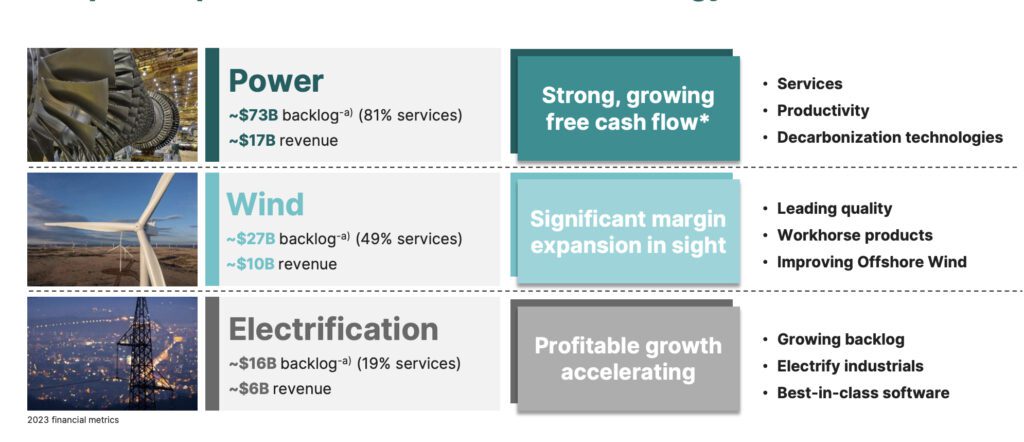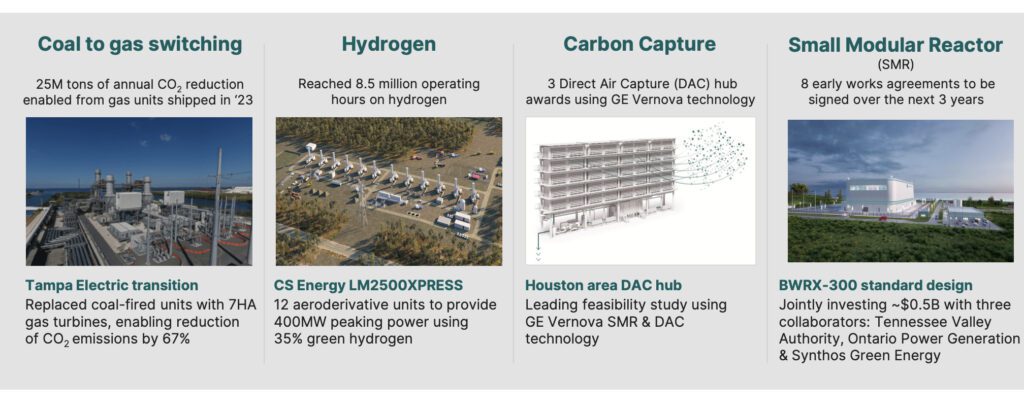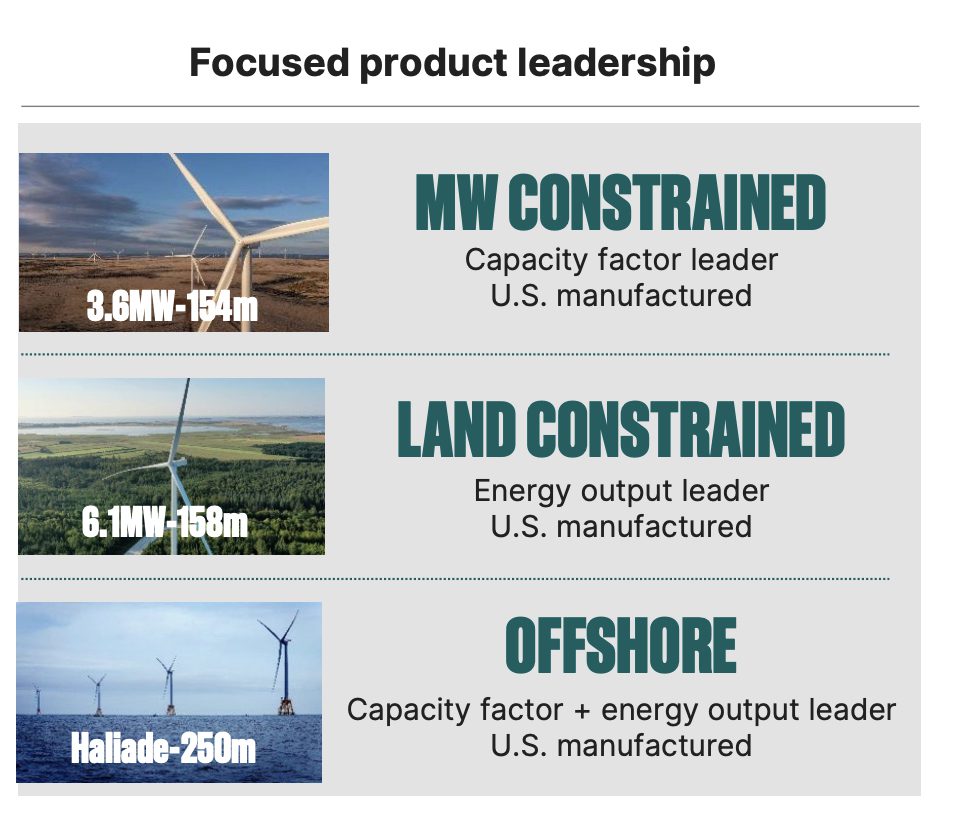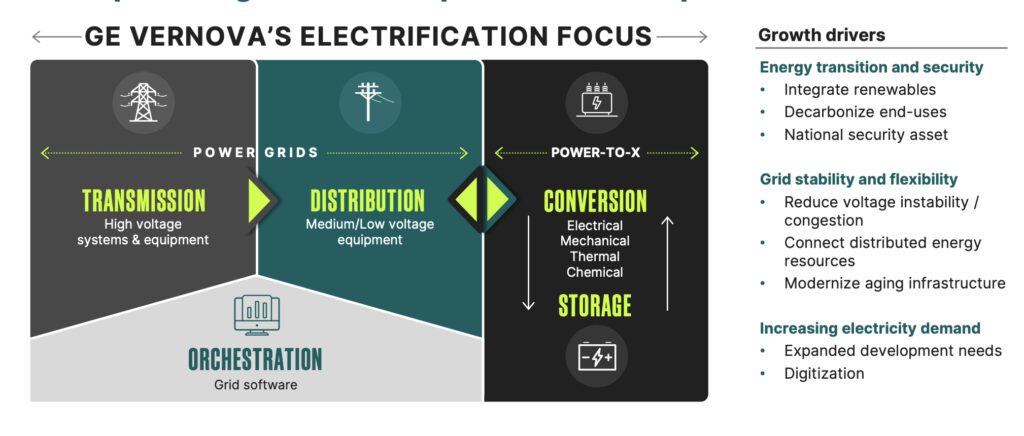A Bold Beginning: GE Vernova Charts Course for Electrification and Decarbonization in Market Debut
Marking the completion of its spin-off from GE, GE Vernova began trading on the New York Stock Exchange on April 2 as an independent company “singularly focused” on accelerating the energy transition.
The measure, approved by GE’s Board on Feb. 29, effectively establishes GE Vernova as a giant purpose-built firm that will leverage its technology and solutions to empower electrification and decarbonization. The company embarks on its corporate path housed at its new headquarters in Cambridge, Massachusetts, with more than 80,000 employees across more than 100 countries—and a vast customer base that includes many of the world’s leading utilities, developers, governments, and large industrial users.
The new firm is comprised of three key segments: Power (composed of its Gas, Steam, Hydro, and Nuclear divisions); Wind (which includes Onshore Wind, Offshore Wind, and LM Wind Power); and Electrification (comprising Grid Solutions, Power Conversion, Solar & Storage Solutions, and Electrification Software).
As company executives underscored during GE Vernova’s inaugural Investor Day on March 6, the company’s mission will be shaped by three core values: sustainability, innovation, and lean. However, the company will continue its concerted focus on its customers, including “to accelerate the path to more reliable, affordable, and sustainable energy while helping its customers’ power economies and deliver the electricity that is vital to health, safety, security, and improved quality of life.”

A Transformational Opportunity
For Scott Strazik, GE Vernova’s CEO, the company’s mission and outlook represent a behemoth opportunity. The market for GE Vernova’s key offerings has ripened, driven by global trends toward electrification and decarbonization, Strazik suggested. Today, the energy sector, already on a growth trajectory for transformation, is grappling equally with a surge in new power demand—including from data centers and artificial intelligence—and a push for sustainable energy solutions, he said.
“In the U.S., the load demand from data centers in 2020 was about 2% of the total load demand. Many people project that to be closer to 8% by 2030—substantial growth,” he noted. “Our U.S. customers in my 25 years with the company have not seen this dynamic of load growth, highly driven by things like data centers and artificial intelligence.”
The company’s installed fleet of gas turbines has, meanwhile, grown to 7,000, and 70% of Gas Power’s businesses is focused on services, he noted. Enthusiasm for new nuclear, driven by decarbonization, has at the same time opened up opportunities for GE Hitachi’s BWRX-300 small modular reactor. Growth in wind power, grid solutions, and electrification also present “real demand and real opportunities,” he said.
“We see these market dynamics that are driving a clear trajectory of multi-decade growth. And they’re happening at the exact same time we’re running these businesses better. Foundationally, sustainability is where it starts,” Strazik said during the Investor Day in March. “Continuing to invest in innovation with a lean operating system that allows our teams to prioritize the critical KPIs most important to our customers, while simultaneously finding space and oxygen to invest in long-term breakthroughs. And that’s very much the journey we’ve been on in Gas Power for over five years. We’re seeing results. We’re accelerating that journey with each of our businesses.”
When all this is coupled together—“the markets, running these businesses better”—it gives GE Vernova a “high degree of confidence in the financials for GE Vernova going forward and our ability to create substantial value for the company from here,” he said.
GE Vernova: A Bold New Chapter in a Lengthy HistoryGE Vernova’s independence from GE marks a notable new direction, particularly given the context of GE’s long history. GE has been a flagship name in the power generating business since 1896, when it became one of the first companies listed on the newly formed Dow Jones Industrial Average. By 1901, GE had successfully developed a 500-kW Curtis turbine generator, and in 1948, it installed a pioneering heavy-duty gas turbine for power generation at the Belle Isle Station in Oklahoma. Then, in 1957, the company connected the first nuclear reactor to a commercial electricity grid. GE’s contributions to power generation technology have continued in a steady stream over the decades. In 2010, however, to maintain financial stability during the global financial crisis, GE’s power businesses were grouped under GE Energy, a division headquartered in Atlanta—and the company was ultimately split into three businesses. These included GE Energy Services, which included grid-related businesses, power services, industrial solutions, and parts and repair; GE Power & Water, which included its full array of power generation and delivery technologies, including its gas and steam turbines, renewable energy, and nuclear energy (GE Hitachi Nuclear Energy, a joint venture with Hitachi); and GE Oil & Gas, which housed its segments catering to the oil and gas production industry. In 2015, the company marked another major business milestone as it took over competitor Alstom in a $10.1 billion deal, and integrated the giant global equipment firm’s products and services into its portfolio. And the year before, it launched the HA heavy-duty gas turbine, a new gas turbine technology that GE’s engineers leveraged to achieve a 62.22% combined cycle net efficiency (at EDF’s Bouchain plant in 2016 with a 9HA.01 unit) and 63.08% combined-cycle gross efficiency (at Chubu Electric Power’s Nishi Nagoya plant in 2018 with a 7HA.01 unit). In the backdrop, to boost revenues and cement the company’s future, it moved to invest $4 billion over half a decade to transform the firm into a “digital industrial” company. See a timeline of GE Vernova’s gas turbine milestones here: “A Brief History of GE Gas Turbines.“ In 2018, weeks after GE Chairman and CEO H. Lawrence Culp Jr. was appointed to replace John Flannery, GE announced it planned to divide GE Power into two units: GE Gas Power, composed of Gas Power Systems and Power Services, and GE Power Portfolio, comprising Steam Power Systems, Grid Solutions, GE Hitachi Nuclear, and Power Conversion. Grid Solutions was later transferred to GE Renewable Energy. In December 2020, GE took another turn to address rapidly shifting market fundamentals, publishing a wide-ranging white paper that formalized its “all-in” stance to combat climate change. The white paper argues that decarbonization of the power sector—which it defines as “the reduction of carbon emissions on a kilogram per MWh basis”—and electrification of energy use sectors is “mired in defining and debating an ideal future state and the timeline by which society would achieve that end-state.” Nearly a year later, in November 2021, GE announced a plan to split the historic conglomerate into three separate investment-grade companies focused on healthcare, energy, and aviation. The effort, which focused on debt reduction, effectively kicked off the development of a stand-alone energy business that combined its GE Power, GE Renewable Energy, and GE Digital business segments. The move “aligns with customer decisions to decarbonize, and asset-balancing decisions can best be solved with [an] integrated top-of-the-house approach,” the company said. The new company was ultimately branded “GE Vernova.” “Vernova” signifies the “combination of ‘ver,’ derived from ‘verde’ and ‘verdant,’ to signal the greens and blues of Earth, and ‘nova,’ from the Latin ‘novus,’ or ‘new,’ reflecting a new and innovative era of lower-carbon energy that GE Vernova will help deliver,” as Chief Communications Officer Kristin Carvell has explained. |
A Promising Power Market
During the Investor Day, GE Vernova’s business segment heads also pointed to optimistic market trends that could potentially drive growth.
Maví Zingoni, GE Vernova’s new CEO of Power, suggested the company’s gas turbine legacy will continue to thrive. “So far, gas has proved to be the best technology when it comes to giving an answer to the energy transition trilemma. And that’s the reason why our customers are investing not only in upgrades in the current installed base but they are also investing in new units,” she said.
“If you take a look at the market, five years ago, the market for heavy-duty new units was 32 GW. Last year, it was 42 GW. The next year, we think that’s going to be in the 40 GW area,” she added. “We are seeing that demand for our largest and most efficient unit, the H-class. When we started to commission the first one seven years ago, and up to now, we have more than 100 units running and operating, more than 2.3 million hours of experience of operations in our growing installed base. But on top of that, this is a unit that is being built to run at very high capacity factors. So you have a growing installed base and high capacity utilization. It drives services,” she said.
GE Vernova’s vast 800-GW gas-fired installed base has continued to be a very resilient, Zingoni noted. “Despite the impacts of COVID or the geopolitical tensions that we are going through and also the gas price volatility, the utilization of these fleets in the last year has been going up low single-digits on average every year. Customers need this gas power,” she said. “And that’s the reason why they keep on investing in it. They invest in upgrades, upgrades to increase output, to improve efficiency, to have better flexibility, to have faster ramp-ups or more efficient turndowns in case that there is a peak in demand and the grid needs to be stabilized.”

Vic Abate, CEO of Wind at GE Vernova, shared similar optimism about GE Vernova’s wind offerings. The outlook is bright, he suggested. “You’ll see wind going from 7% of the electricity to the grid today to where 25% of the power generation globally will come from wind. Just pause for a second and digest that point,” he said. “Think of an energy system where 1 out of 4 electrons comes from wind because this is a different world. And this is why we believe there’s a premium to be gained from reliability, quality, and uptime because this is high-tech infrastructure that’s being deployed at an unprecedented scale.”
However, Abate noted GE Vernova’s Wind segment planned to reduce the number of its product variants in compliance with the company’s “lean” strategy. “We focused our learnings on our fleet of 55,000 wind turbines, leveraging the 4 billion operating hours of insight and information. And, we’ve picked products that win in markets that we care about,” he said. These “workhorse” products will include GE Vernova’s 3.6-MW 154-meter rotor wind turbine for megawatt-constrained applications, its 6.1-MW 158-meter turbine for land-constrained applications, and its 250-meter rotor Haliade-X for offshore applications.

“We talked a lot about lean, and how we were going to drive structural productivity and transform the Onshore business using lean and here are some of the results,” Abate said. “First, we’ve reduced layers, effectively bringing our teams closer to our customers. We’ve simplified and focused our R&D spend with the three workhorse products that we talked about. We’re consolidating our footprint to create stronger, more capable communities of practice. And finally, we’ve repositioned our manufacturing resources closer to strategic markets.”
Philippe Piron GE Vernova, CEO of Electrification Systems, was as optimistic. “Overall, electrification is the backbone of the energy transition towards this net-zero energy system, and this is why we are benefiting from this fantastic growth. From $75 billion in 2022, we expect the addressable market by GE Vernova to more than double in 2030. GE Vernova is covering the full value chain of electrification from the point of generation to the point of consumption,” he said.
“I must admit we have a unique positioning here. Our equipment evacuates the electricity from conventional power plants or renewables transmitted at the international or national level with high-voltage direct current or alternative current transmission systems, and it flows afterward to the distribution grid at the regional or local level, to finally being converted into another kind of energy necessary for each end-use,” he added.
“For instance, mechanical energy with electrical motors, thermal energy with electrical furnaces, chemical energy with battery storage or electrolyzer. On power grids, orchestration allows to monitor and to conduct the full infrastructure. We are strong on grid transmission and primary distribution, but we are leading edge on grid orchestration and digitization to supervise electrical networks, which are becoming more and more complex.”

The future of power will hinge on imperatives, Piron suggested. These include “the imperative of energy transition with the rise of the low carbon intensity energy for sure, but as well energy security,” he said. The second big growth driver will include the need for grid stability and flexibility, he predicted.
Finally, the most obvious growth driver relates to growing demand. “The global increasing demand for electricity [accounted] for 20% of world energy consumption in 2022,” he noted. “Electricity would need to reach 50% in 2050 to reach the net zero objectives. To capture efficiently this profitable growth, GE Vernova is committed to develop top-notch technologies that allow us to secure a leading-edge positioning,” he said.
—Sonal Patel is a POWER senior editor (@sonalcpatel, @POWERmagazine).